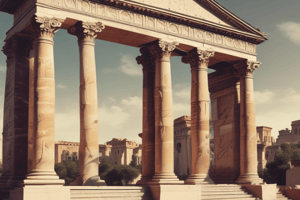Podcast
Questions and Answers
What is a Composite Capital?
What is a Composite Capital?
- A simple capital made of wood
- A type of roof structure
- A capital with an ornate combination of Ionic volutes and Corinthian acanthus leaves (correct)
- A type of column with no decoration
What is an aisle in a church?
What is an aisle in a church?
The portion of a church flanking the nave and separated from it by a row of columns or piers.
What is an amphitheater?
What is an amphitheater?
A Roman building type resembling two Greek theaters put together, featuring a continuous elliptical cavea around a central arena.
What is an apse?
What is an apse?
What is an arch?
What is an arch?
What is an arena in a Roman amphitheater?
What is an arena in a Roman amphitheater?
What is an atrium?
What is an atrium?
What is a basilica?
What is a basilica?
What is concrete?
What is concrete?
What is a drum in architecture?
What is a drum in architecture?
What is fenestration?
What is fenestration?
What is a forum?
What is a forum?
What is a groin?
What is a groin?
What is a nave?
What is a nave?
What is an oculus?
What is an oculus?
What is porphyry?
What is porphyry?
What is a pseudoperipteral temple?
What is a pseudoperipteral temple?
What is skenographia?
What is skenographia?
What is a spandrel?
What is a spandrel?
What is a coffered ceiling?
What is a coffered ceiling?
What is an Attached/Engaged Column?
What is an Attached/Engaged Column?
What is a niche?
What is a niche?
What is a stringcourse?
What is a stringcourse?
What is an aedicule?
What is an aedicule?
What is a pilaster?
What is a pilaster?
Flashcards are hidden until you start studying
Study Notes
Architectural Elements
- Composite Capital: Features a blend of Ionic volutes and Corinthian acanthus leaves, popular in Roman architecture.
- Aisle: The area beside the nave in a church, separated by columns or piers, enhancing space and movement.
- Amphitheater: A Roman structure resembling two Greek theaters merged, featuring an elliptical cavea surrounding a central arena.
- Apse: A semi-circular recess in basilicas or Christian churches, typically located at the east end.
- Arch: A curved structure spanning openings, made of wedge-shaped blocks (voussoirs), also used for firebreaks as in diaphragm arches.
Key Structures and Spaces
- Arena: The central part of a Roman amphitheater where gladiatorial games and events occurred.
- Atrium: An open, sky-lit court in Roman homes or in front of Christian basilicas, serving as a gathering space.
- Basilica: Rectangular assembly buildings in Rome, later adapted for Christian worship, with distinct entry and apse features.
- Concrete: An innovative building material of the Romans, composed of lime, volcanic sand, and small stones, contributing to architectural durability.
- Drum: The supporting circular wall for domes, also refers to cylindrical stones in non-monolithic columns.
Design Aspects
- Fenestration: The arrangement and design of windows in a building, influencing natural light and aesthetics.
- Forum: The central public square in ancient Roman cities, a hub for commerce and social interaction.
- Groin Vault: Formed by intersecting two barrel vaults, reducing the need for buttressing while appearing lighter.
- Nave: The central part of a church, extending from the entrance to the choir, divided from aisles by piers or columns.
Visual Features
- Oculus: A round opening at the dome's center, allowing light and air circulation; found in both Roman and Gothic architecture.
- Porphyry: A valued purple marble used in Roman architecture, symbolizing luxury and status.
- Pseudoperipteral: This architectural style features engaged columns around a temple's cella, emulating a peripteral colonnade.
- Skenographia: Greek term meaning "scene painting," employing linear perspective for depth in artistic representations.
Decorative and Structural Functions
- Spandrel: The triangular space between arches and horizontal connections, adding to structural integrity and decoration.
- Coffered Ceiling: Ceilings featuring sunken panels, adding aesthetic appeal and reducing weight in architectural designs.
- Attached/Engaged Column: A column fixed to a wall, providing structural support while appearing decorative.
- Niche: A wall recess designed to hold statues, enhancing the visual interest within the space.
- Stringcourse: A horizontal decorative band running across a wall, adding rhythm to the architectural facade.
- Aedicule: A decorative framework around openings, consisting of an entablature and pediment supported by columns or pilasters.
- Pilaster: A flattened column attached to a wall, serving both structural and ornamental purposes in architecture.
Studying That Suits You
Use AI to generate personalized quizzes and flashcards to suit your learning preferences.




